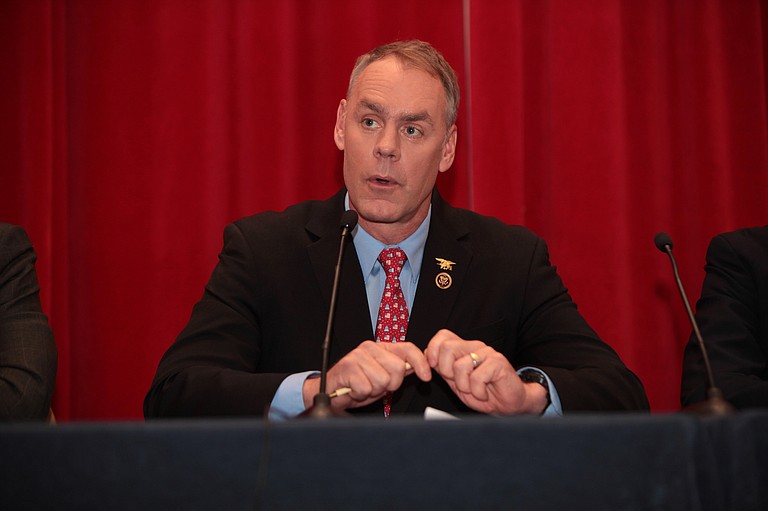Interior Secretary Ryan Zinke said he's recommending that none of 27 national monuments carved from wilderness and ocean and under review by the Trump administration be eliminated. Photo courtesy Flickr/Gage Skidmore
Thursday, August 24, 2017
BILLINGS, Mont. (AP) — Interior Secretary Ryan Zinke announced Thursday he won't seek to eliminate any national monuments carved from the wilderness and oceans by past presidents. But he said he will press to change some boundaries and left open the possibility of allowing drilling, mining or other industries on some of the land.
Twenty-seven monuments in all were put under review in April by President Donald Trump, who has charged that the millions of acres placed under protection by President Barack Obama were part of a "massive federal land grab."
If Trump adopts Zinke's recommendations, it could quiet some of the worst fears of his opponents, who warned that vast public lands and marine areas could be stripped of federal protection.
But significant reductions in the size of the monuments or changes to what activities are allowed on them could trigger fierce resistance, too, including lawsuits.
In an interview with The Associated Press, Zinke said he is recommending changes to a "handful" of sites, including unspecified boundary adjustments, and suggested some monuments are too large.
The White House said only that it received Zinke's recommendations and is reviewing them.
Conservationists and tribal leaders responded with alarm and distrust, demanding the full release of Zinke's recommendations and vowing to challenge attempts to shrink any monuments.
Jacqueline Savitz, senior vice president of Oceana, which has been pushing for preservation of five marine monuments included in the review, said that simply saying "changes" are coming doesn't reveal any real information.
"A change can be a small tweak or near annihilation," Savitz said. "The public has a right to know."
A tribal coalition that pushed for the Bears Ears National Monument on sacred tribal land in Utah is prepared to launch a legal fight against even a slight reduction in size, said Gavin Noyes of the nonprofit Utah Diné Bikéyah.
Zinke did not directly answer whether any monuments would be newly opened to energy development, mining and other industries Trump has championed.
"There's an expectation we need to look out 100 years from now to keep the public land experience alive in this country," Zinke said. "You can protect the monument by keeping public access to traditional uses."
None of the sites would revert to new ownership, he said, while public access for uses such as hunting, fishing or grazing would be maintained or restored. He also spoke of protecting tribal interests.
The recommendations cap an unprecedented four-month review based on a belief that the century-old Antiquities Act had been misused by past presidents to create oversized monuments that hinder energy development, grazing and other uses. The review looked at whether the protected areas should be eliminated, downsized or otherwise altered.
The review raised alarm among conservationists who said protections could be lost for ancient cliff dwellings, towering sequoia trees, deep canyons and ocean habitats.
Zinke previously announced that no changes would be made at six of the 27 national monuments under review — in Montana, Colorado, Idaho, California, Arizona and Washington. He has also said that Bears Ears should be downsized.
In the interview with the AP, the former Montana congressman declined to reveal specifics on individual sites.
He also struck back against conservationists who had warned of impending mass sell-offs of public lands by the Trump administration.
"I've heard this narrative that somehow the land is going to be sold or transferred," Zinke said. "That narrative is patently false and shameful. The land was public before and it will be public after."
National monument designations add protections for lands revered for their natural beauty and historical significance, with the goal of preserving them for future generations. The restrictions aren't as stringent as those at national parks but can include limits on mining, timber-cutting and recreational activities such as riding off-road vehicles.
The monuments under review were designated by four presidents over the past two decades. Several are about the size of the state of Delaware, including Mojave Trails in California, Grand-Staircase Escalante in Utah and Bears Ears.
Many national monuments were later declared national parks. Among them were Zion National Park in Utah and Grand Canyon National Park in Arizona.
No other president has tried to eliminate a monument, but some have trimmed and redrawn boundaries 18 times, according to the National Park Service.
Many times, presidents reduced monuments slightly, such as when Franklin Roosevelt removed about 52 acres from Arizona's Wupatki National Monument in 1941 to make way for a dam.
But occasionally the changes were drastic, such as President Woodrow Wilson's move in 1915 to cut Mount Olympus National Monument roughly in half to open more land for logging.
Environmental groups contend the 1906 Antiquities Act allows presidents to create the monuments but gives only Congress the power to modify them.

Comments
Use the comment form below to begin a discussion about this content.
Sign in to comment
Or login with:
OpenID